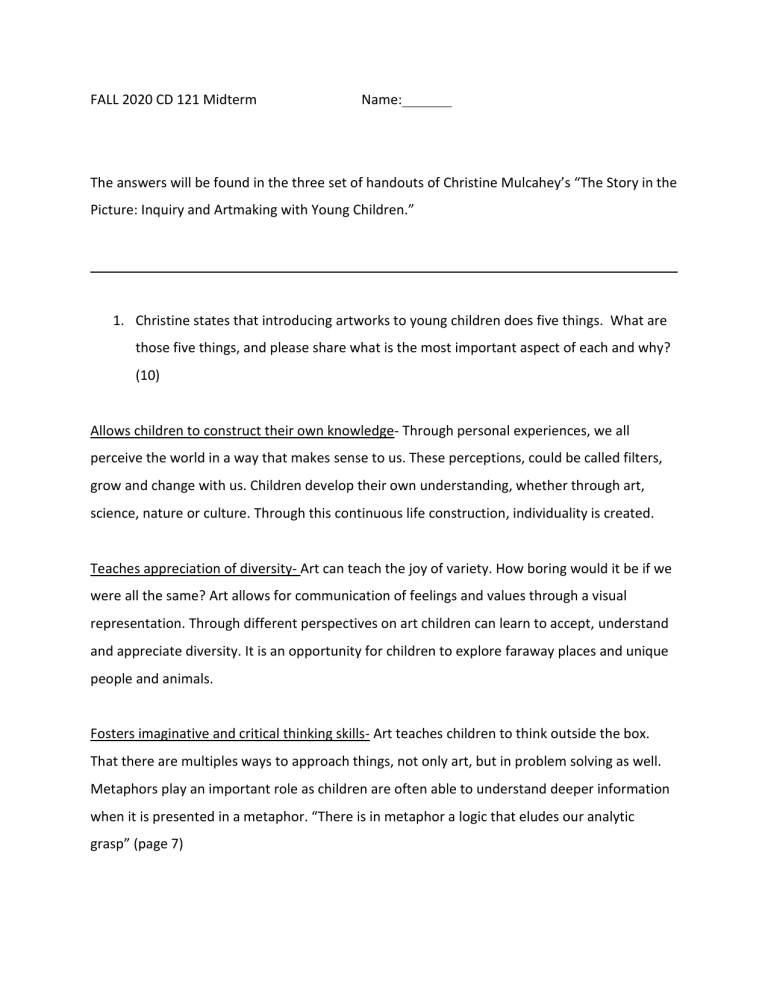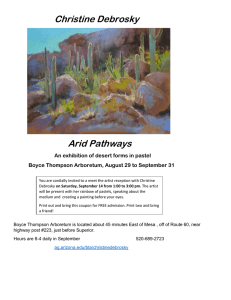
FALL 2020 CD 121 Midterm Name: The answers will be found in the three set of handouts of Christine Mulcahey’s “The Story in the Picture: Inquiry and Artmaking with Young Children.” 1. Christine states that introducing artworks to young children does five things. What are those five things, and please share what is the most important aspect of each and why? (10) Allows children to construct their own knowledge- Through personal experiences, we all perceive the world in a way that makes sense to us. These perceptions, could be called filters, grow and change with us. Children develop their own understanding, whether through art, science, nature or culture. Through this continuous life construction, individuality is created. Teaches appreciation of diversity- Art can teach the joy of variety. How boring would it be if we were all the same? Art allows for communication of feelings and values through a visual representation. Through different perspectives on art children can learn to accept, understand and appreciate diversity. It is an opportunity for children to explore faraway places and unique people and animals. Fosters imaginative and critical thinking skills- Art teaches children to think outside the box. That there are multiples ways to approach things, not only art, but in problem solving as well. Metaphors play an important role as children are often able to understand deeper information when it is presented in a metaphor. “There is in metaphor a logic that eludes our analytic grasp” (page 7) Encourages storytelling- They say a picture is worth a thousand words. For a child to be able to imagine a story through a visual art pieces and communicate this story requires higher level thinking. They need the ability to interpret emotions and verbalize their thoughts. Allows children to share personal experiences-Emotional intelligence begins with relating to your own personal experiences. Empathy and kindness arise from the ability to relate others experiences to their own. Through art children can share their lives and emotions. 2. Christine states that are four “What’s, Why’s, and How’s” we should think like an artist. Choose one of each and explain why each is important. (10) What does it mean to think like an artist? -It means we look at things closer than most people do. Viewing details of an environment, object or situation means we are still and present. It means being in the moment with whatever it is we are perceiving. It means to notice, color, texture, sound, scent and how things relate to each other. An artist will find the light and admire the shadows. Why should we think like an artist? -We find beauty and complexity in everyday things and situations. The simple appreciation and momentary acknowledgment of everyday things creates a connection to our world and to each other. Finding this beauty fosters kindness and empathy, love and acceptance. This connection is vital for people to learn to care for the planet and all its creatures. Recognizing the complexity brings humility and awe. How do we think like an artist? - We look, think, feel, smell, touch and enjoy the world. This is the basis to a happy life. In the words of Thich Nhat Hanh “Each time you look at a tangerine, you can see deeply into it. You can see everything in the universe in one tangerine. When you peel it and smell it, it’s wonderful. You can take your time eating a tangerine and be very happy.” Sense perceptions allow us to escape our minds and experience our world completely. 3.What are Christine’s concerns with coloring books and tracing? Explain each. (10) “Coloring books are adult-generated images designed to occupy children’s time.” (page 18) Coloring books and tracing do not allow for any creation or self-expression. It tells children what something should look like, even if it is an unobtainable end product for a child to achieve on their own. It teaches children that all the art should look the same and children have little interest in this form of “art”. Drawing from observation deepens the learning and strengthens the memory of the learning, whereas tracing does not teach anything about the thing they are tracing. 4.Christine states that a rich art activity has six characteristics. What are those six things, and please share what is the most important aspect of each and why? (15) Asking what the children will learn rather than what the children will do-In order to create a deeper learning experience, it is important to have a thoughtful purpose in the planned activity. It is easy to just have them paint an animal, but how can the teacher bring the learning into it? What will they find interesting and what questions could the activity bring about? Connecting to the larger art world-being introduced to exemplary artists allow for children to see the world with different perspectives. Exploring the human psyche by asking why an artist may have created a piece in the way that they did. It also is a way to explore a bigger world and the vast variety of people, animals, culture and environments. Allowing children to make choices-So much of a child’s life is directed and they can often times have very little choice in how things go. Having the choices in art, allows them to express themselves freely, without correction or judgement. It enables them to feel as though they have some control and that lessens anxiety which is so prevalent in our youth today. It also allows for children to learn more about art and the different materials and properties. Asking children to think like an artist- thinking like an artist brings children into the moment and in touch with their sense perceptions. They learn to see different ideas and perspectives and appreciate the everyday things. Providing a variety of outcomes- “There is no right or wrong way to begin or finish” (page 25) The children’s art will reflect their own experiences and perspectives of their world. In allowing for this, a child feel valued in who they are and being able to express themselves. Avoiding recipe orientated activities- There is no thinking, no creation, no self-expression, no learning, no inspiration and no uniqueness in these activities. This also creates an expectation that the art should look exactly the same. This may be unobtainable for some children and also does not enable the child any choice or connection to art. 5. Christine states that conversations with young children about artworks are important. How would you facilitate and why? (5) I would start by showing the children a variety of art pieces in line with the curriculum plan. I would ask open- ended questions about the art such as “What do you see?” “How do you think the artist created this look?” “Why do you think they chose those colors?” etc. and see where the conversation leads. I would also start with young children in having them point out the shapes, lines and colors in the art. This is important as it helps them make a connection to the artist and art. It increases their vocabulary, helps them see natural differences, and helps develop empathy. 6. What does Christine say about “making assumptions” and “complementing” children’s artwork? Do you support these thoughts? Why/Why not? (10) Making assumptions in regards to children’s artwork can be detrimental to the child. It can be difficult to decipher a work of art and by making judgements without having a conversation with the artist, most likely the judgment would be incorrect. I agree that it is important for the child to be able to express themselves knowing the work will not be judged and for them to be able to decide for themselves if it is good art. By simply acknowledging what actually is in the art, the child can engage in a thoughtful conversation about their art. It is good to discuss the elements of the art or use it as a beginning for storytelling. 7.Christine specifically explores 3 concepts of art. What are they and why these? (5) Lines, shapes and color-It is easy for children to follow discussions on lines and to understand shapes. Lines and shapes can be found in realistic and abstract artwork and can easily be pointed out and discussed. Lines, shapes and colors are found in our natural environment and help create a connection to nature through art. Rich language can come from these three elements, especially when we work with adjectives and metaphors. Metaphors stimulate the imagination and create a better understanding of many concepts. A variety of materials can be used to work with these elements as well, such as; yarn, leaves, wire, string, etc. Color creates opportunities for exploration and discovery. 8.Choose a concept from the ones in Chapter Five (families and friends, faces and emotions, transportation, architecture, animals, birds, plants, etc.) and explain how you would incorporate it into your children’s activities, from beginning to end. (10) Using the natural world category, I would focus on the beach and seaside, including birds and other creatures that could be found there. I would begin by setting the environment with elements of the beach. I would display photos of shells, shore birds, turtles, choosing photos with patterns such as nautilus shells, sea stars, turtle shells, pier pilons, etc. and have books displayed for inspiration such as Wave by Suzy Lee. I would have a discovery area with elements from the beach such as shells, feathers and seaweed and outside have a seaweed sensory bin. I would have paint and canvas set up in the art studio with beach items to use for painting, such as gull feathers, shells, interesting shaped stones, and dried seaweed along with various size brushes. I would then gather the children with a song such as “Down by the Shore”. Next, I would begin a discussion about the beach and have the children talk about experiences they have had there. This would lead into a reading of Wave which is actually wordless but is beautifully illustrated and tells a wonderful story of an interaction between a child and a wave. The children would be given the opportunity to share what they see happening in the illustrations. When this is finished, the children would be invited to paint and Wave would be opened and displayed on the table along with shells and natural items from the shore. As the children finish the art would be allowed to dry and would clean up the area. I would document the activity with photos and display them in a well trafficked area of the classroom along with narration from the book reading and art activity. The children could choose to display their paintings or take them home. 9.Please explain how Christine uses documentation with families and how would you use it in your classroom of young children? (5) Christine uses documentation as a way to communicate with families about art “experiences”. It begins with introducing the families to the approach to art with facts and suggestions to help support the children. Because art education does not only include producing art, documenting the activities and explorations through photographs and adding portions of conversations and new vocabulary to be displayed in the classroom, helps the families to be more involved and understand what is taking place in their child’s life. I agree with the importance of all of these methods and would utilize them in my own classroom. I also would want to create the takehome portfolio, as she suggested, with sample artwork and questions to create the connection between school and home.
